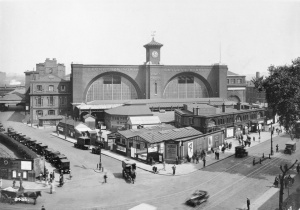Heritage plays a crucial role in informing, limiting or catalysing urban regeneration. Through conservation and listed building regulations the Local Authority gains leverage to pursue the public agenda as much as private developers can rely on a market advantage to ensure positive outcome for their investments. We would like to hear your point of view on four key regeneration projects that have shaped London over the last 50 years: Covent Garden, the Tate Modern with South Bank, King’s Cross and the Battersea Power Station.
Sir Donald Insall (DI): Covent Garden retains its role as heart of a quintessential neighbourhood of London. Its importance and special character come not only from its Opera House, one of the finest in Europe, but also from St Paul’s Church (Inigo Jones’ “finest barn in Europe”) and its two flanking gateways – the northern one restored, with a refreshed environment for that on the south. The Market, Flower Hall and Opera House are all so very individual, but interact with each other to create a throbbing area of the capital. Their significance and importance stand high in the scale of assets for London, and they have been largely retained and are increasingly enjoyed today. London has been lucky in comparison with other popular examples of regeneration of historical markets in European Capitals (yes – perhaps even Les Halles, in Paris) and the regeneration of Covent Garden has not imposed a “restoration” policy over an entire historic site, but has found a harmonious continuation in a vibrant way.
The Tate Modern was a very special creature. The original function of the building has gone, but its magnificent shell has remained and has represented a potential asset for an entirely different activity. The building is extremely grand, beautifully situated and its reuse has included a re-casting of a vast vacant interior, as part of a spirited resurgence of London’s active South Bank. Perhaps the only sad note in the music has been the loss of function of County Hall, which surely deserved the distinction for which it was built. The whole of South Bank has now emerged as a unit, with extra life given back to it in the most astonishing way, and with increasing links across the Millennium Bridge. Both sides of the river represent a positive asset for different visitors, the Tate Modern being a particular success for all manner of folks. It is a real hub of activities. The revival of South Bank started with the Festival of Britain, and the post-war realisation of it attractions and value for Londoners and visitors. It is a success story.
Another success story is King’s Cross. This started from the Station, the revival of which was so long overdue, and side-by-side with that of St Pancras – the two contrasting so delightfully. Part of their original history generated the different architectural solutions – King’s Cross was originally approached by rail under the Canal, and its architectural form was generated by the duality of departure and arrival. Long masked by the forecourt agglomeration outside, now being cleared, the station has acquired a new concourse, giving opportunity for exciting modern roof construction and set in clear juxtaposition, abutting the original flank facade. St Pancras, on the other hand, has demonstrated its own problems and opportunities, largely brought about by the fact that the railway comes in at a higher level over the Canal, thus producing large undercroft areas, originally used for storage but now revealed and used. The hotel was not immediately re-established but is now alive again. The area between the two great buildings had fallen into extreme decay, and has offered opportunity for thoroughgoing reorganisation and replacement buildings. The regeneration of King’s Cross contrasts with the story of Covent Garden and Tate Modern, as it has offered greater opportunity for modern architects, stimulated by the continuity of the grand older neighbours.
The regeneration of the Battersea Power Station area is again, very different. How unfortunate it has been that circumstances brought such a complicated take-up of opportunity! A building with interiors and function entirely gone, changing hands so many times and so expensively, that many now feel that the surrounding redevelopment may have to be more dense than is desirable architecturally. As for the old Power Station itself, my own wish would be that the distinguished chimneys should have appeared more as a unity with their base. I find it strange that now they appear in white dress floating above! There are inevitably feelings among Londoners that the scale and cost of new development are attracting so many overseas buyers who might never live there, and that the social vitality of the neighbourhood may be hard to maintain.
Public attitudes to all these schemes have been changing in an encouraging way, and the arrival and existence of English Heritage has helped beyond imagination. We must not forget that despite the economic pressures, so hard to control, and all the huge resulting skyline changes, London has still been able to retain much of the unique character which might have otherwise have been lost.

